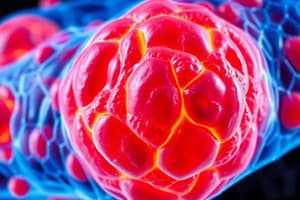Podcast
Questions and Answers
Which of the following is NOT a potential symptom of VIN?
Which of the following is NOT a potential symptom of VIN?
- Mild to severe itching or burning on the vulva
- Changes in the skin color on the vulva
- Thickening of the skin on the vulva
- Pain in the abdomen (correct)
What is the difference between VIN 1 and VIN 3?
What is the difference between VIN 1 and VIN 3?
- VIN 1 is more severe than VIN 3, affecting the deeper layers of the vulva.
- VIN 1 and VIN 3 are both severe, but VIN 3 involves a larger area of the vulva.
- VIN 1 is less severe than VIN 3, with abnormal cells affecting a smaller portion of the vulvar skin. (correct)
- VIN 1 is more common than VIN 3, with a higher chance of successful treatment.
Which of these is a potential treatment option for VAIN?
Which of these is a potential treatment option for VAIN?
- Anti-inflammatory medications
- Topical chemotherapy (correct)
- Hormone therapy
- Antibiotics
Which of these is NOT a method used to diagnose VIN or VAIN?
Which of these is NOT a method used to diagnose VIN or VAIN?
What does VAIN 3 represent?
What does VAIN 3 represent?
Which of the following is a treatment option for VIN that involves removing the abnormal cells surgically?
Which of the following is a treatment option for VIN that involves removing the abnormal cells surgically?
What does 'carcinoma in situ' mean?
What does 'carcinoma in situ' mean?
Which of the following is a potential side effect of laser therapy for VAIN?
Which of the following is a potential side effect of laser therapy for VAIN?
Which of the following is NOT a characteristic of cervical dysplasia?
Which of the following is NOT a characteristic of cervical dysplasia?
What is the most common initial test for cervical dysplasia?
What is the most common initial test for cervical dysplasia?
Which of the following is a treatment option for precancerous changes in the cervix?
Which of the following is a treatment option for precancerous changes in the cervix?
What is the difference between AGC and AIS?
What is the difference between AGC and AIS?
Which of the following is NOT a type of precancerous condition of the uterus?
Which of the following is NOT a type of precancerous condition of the uterus?
How is an endometrial biopsy typically performed?
How is an endometrial biopsy typically performed?
Which of these options is a procedure that removes cells from the endocervical canal?
Which of these options is a procedure that removes cells from the endocervical canal?
Flashcards
Vulvar Intraepithelial Neoplasia (VIN)
Vulvar Intraepithelial Neoplasia (VIN)
A precursor lesion in vulvar tissues categorized by abnormal cell growth.
VIN 1
VIN 1
Abnormal cells invade less than one-third of the top vulvar skin layer.
VIN 2
VIN 2
Abnormal cells invade less than two-thirds of the top vulvar skin layer.
VIN 3
VIN 3
Signup and view all the flashcards
Symptoms of VIN
Symptoms of VIN
Signup and view all the flashcards
Vaginal Intraepithelial Neoplasia (VAIN)
Vaginal Intraepithelial Neoplasia (VAIN)
Signup and view all the flashcards
VAIN 1
VAIN 1
Signup and view all the flashcards
Treatment Options for VAIN
Treatment Options for VAIN
Signup and view all the flashcards
Cervical Dysplasia
Cervical Dysplasia
Signup and view all the flashcards
Atypical Glandular Cells (AGC)
Atypical Glandular Cells (AGC)
Signup and view all the flashcards
Adenocarcinoma in situ (AIS)
Adenocarcinoma in situ (AIS)
Signup and view all the flashcards
Colposcopy
Colposcopy
Signup and view all the flashcards
Loop Electrosurgical Excision Procedure (LEEP)
Loop Electrosurgical Excision Procedure (LEEP)
Signup and view all the flashcards
Study Notes
Precancerous Disease in Gynecology
- Precancerous conditions can affect various reproductive organs, including the vulva, vagina, cervix, and uterus.
- VIN (Vulvar Intraepithelial Neoplasia) is categorized by how deep abnormal cells penetrate the top layer of vulvar skin.
- VIN 1: Abnormal cells are less than one-third of the top skin layer.
- VIN 2: Abnormal cells are less than two-thirds of the top skin layer.
- VIN 3: Abnormal cells extend beyond two-thirds of the top skin layer.
- VIN often has no symptoms, but possible signs include itching, burning, changes in skin color (white, pink, red, gray, dark brown), skin thickening, lumps, or sores.
- Diagnosing VIN involves examining the vulva, vagina, cervix, and anus, colposcopy, and biopsy.
- Treatment options for VIN include no treatment with close monitoring, topical therapy, laser procedures, or surgical removal (wide local excision or simple vulvectomy).
- VAIN (Vaginal Intraepithelial Neoplasia) is classified based on abnormal epithelial cells.
- VAIN 1: Mild dysplasia; mildly abnormal cells.
- VAIN 2: Moderate dysplasia; moderately abnormal cells.
- VAIN 3: Severe dysplasia or carcinoma in situ; significant abnormal cells.
- VAIN diagnosis involves colposcopy and biopsy.
- VAIN treatment may include laser therapy, topical chemotherapy (5-FU), partial vaginectomy, or radiation therapy.
- Cervical Dysplasia (CIN, Cervical Intraepithelial Neoplasia) is abnormal or possibly precancerous changes in cervical cells.
- Levels of severity are LSIL (low-grade), HSIL (high-grade), and cancer.
- Other reporting systems for changes may refer to CIN and cervical dysplasia. CIN categorizes cervical conditions based on severity. CIN1, CIN2, and CIN3 represent increasing severity of abnormal cells.
- Abnormal glandular cells (AGC) and adenocarcinoma in situ (AIS) are changes to glandular cells in cervix.
- AGC: Abnormal glandular appearance.
- AIS: Pre-invasive glandular cancer, where cells haven't spread.
- Diagnosing precancerous uterine conditions involves endometrial biopsy or dilation and curettage (D&C).
- Treatment for atypical endometrial hyperplasia may include hysterectomy (for postmenopausal women) or progesterone therapy (for those wanting future children).
Studying That Suits You
Use AI to generate personalized quizzes and flashcards to suit your learning preferences.




